Science and Remote Sensing Systems
Created by Commodore Wilkan Targaryen on Sat Dec 21st, 2024 @ 1:19pm
Sensor Systems
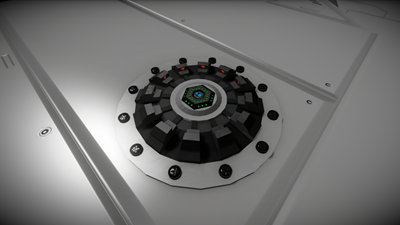 While the Bridge is the Brain of the Starship and Engineering is its heart, the Sensor Systems are a starship’s “eyes” and allow it to investigate not only visible phenomena, but a variety of electromagnetic and physical phenomena that traditional senses cannot perceive. Sensors are rated based upon their operational range over, their strength and efficiency relative to their power requirements, and their ability to overcome interference. All sensors have a maximum effective range and, beyond that range, a sensor’s effects or readings become so attenuated or vague or contradictory that they’re nearly useless to the Enterprise's crew. While starships are outfitted with many different sensor technologies, standard scans exclude some 15,000 substances as they are unusual, rare, and/or exotic materials that occur infrequently in nature. Sensors can be calibrated to search for these substances depending upon need, but typically at the expense of another object they normally detect. Further, scanning beyond the subspace barrier by emitting an inverse tachyon pulse with
the ship’s main deflector, which ordinarily render sensors useless.
While the Bridge is the Brain of the Starship and Engineering is its heart, the Sensor Systems are a starship’s “eyes” and allow it to investigate not only visible phenomena, but a variety of electromagnetic and physical phenomena that traditional senses cannot perceive. Sensors are rated based upon their operational range over, their strength and efficiency relative to their power requirements, and their ability to overcome interference. All sensors have a maximum effective range and, beyond that range, a sensor’s effects or readings become so attenuated or vague or contradictory that they’re nearly useless to the Enterprise's crew. While starships are outfitted with many different sensor technologies, standard scans exclude some 15,000 substances as they are unusual, rare, and/or exotic materials that occur infrequently in nature. Sensors can be calibrated to search for these substances depending upon need, but typically at the expense of another object they normally detect. Further, scanning beyond the subspace barrier by emitting an inverse tachyon pulse with
the ship’s main deflector, which ordinarily render sensors useless.While there are several primary sensor types utilized by the Enterprise, all sensors incorporate an option to conduct either an active or passive scan. Active scans require the ship to use its own energy to conduct the scan and then observe what happens to that energy, with the scan pulses traveling at roughly Warp 9.9997. When conducting an active scan, the crew has control over what it’s looking for, but active scans run the risk of revealing the Enterprise's position to nearby vessels. While the Enterprise crew has less control over what a passive scan can detect, passive scans receive and analyze energy or other phenomena that come to the ship naturally and don’t run the risk of detection.
While sensors are incredible tools, they are not infallible. Regardless of the type of scan conducted, the smaller or more dispersed the subject of a scan is, the harder it will be for scans to detect while some sensor systems have “blind spots” that can be exploited. Further, Sensors are highly susceptible to multiple forms of interference, which are rated on a scale from 1 to 10. Often, Science Officers can overcome interference through a multiphasic scan, which uses energy pulses with overlapping signal frequencies and nutation to overcome the interference, or by conducting a magneton scan. Crews may also try to overcome interference by boosting their sensors with extra power, or they may try to reconfigure the sensors to overcome the interference or by channeling scans through the Main Deflector itself. As a last ditch effort, crews may attempt to emit a modified tetryon pulse, similar to echolocation, to conduct a scan; however, it can only detect other ships and objects within 10,000 kilometers, it can’t differentiate between what it finds, and other vessels with working sensors can easily pinpoint the Enterprise from the scan and move to intercept.
Lateral Sensors
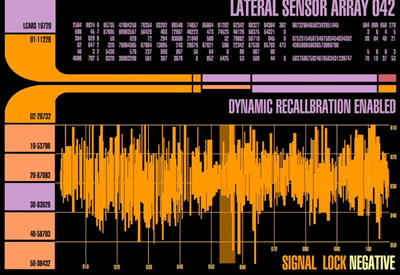 Located along the edges of the Enterprise's outer hull, the Lateral Sensors are short-range sensors comprised of six pallets containing one to six sensor telescopes. The majority of the Enterprise's Lateral Sensors incorporate standard Starfleet sensor packages, but many are fitted with mission configurable sensor packages. Common sensor technologies available include sensors configured to investigate astronomical phenomena, planetary analysis, life-form analysis, EM scanning, passive neutrino scanning, parametric subspace field stress scans for cloaked ships, thermal variances, threat assessment and analysis, and quasi-stellar material telescopes. Located at strategic locations along the ship's hull to maximize signal gain and flexibility, the Lateral Sensors can detect a variety of phenomena from all directions around the vessel and provide redundancy if the Lateral Sensors become damaged. With a maximum effective range of around light-year from the ship, Lateral Sensors employ both active and passive scans and are used to monitor both enemy movement and activities in combat situations.
Located along the edges of the Enterprise's outer hull, the Lateral Sensors are short-range sensors comprised of six pallets containing one to six sensor telescopes. The majority of the Enterprise's Lateral Sensors incorporate standard Starfleet sensor packages, but many are fitted with mission configurable sensor packages. Common sensor technologies available include sensors configured to investigate astronomical phenomena, planetary analysis, life-form analysis, EM scanning, passive neutrino scanning, parametric subspace field stress scans for cloaked ships, thermal variances, threat assessment and analysis, and quasi-stellar material telescopes. Located at strategic locations along the ship's hull to maximize signal gain and flexibility, the Lateral Sensors can detect a variety of phenomena from all directions around the vessel and provide redundancy if the Lateral Sensors become damaged. With a maximum effective range of around light-year from the ship, Lateral Sensors employ both active and passive scans and are used to monitor both enemy movement and activities in combat situations.
Long-Range Sensors
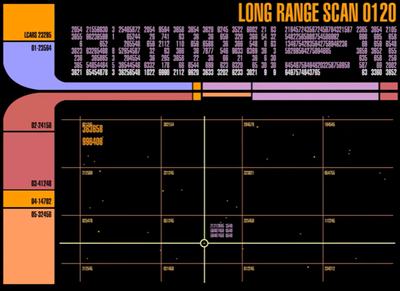 Located behind the Main Deflector Dish, the Long-Range Sensors are active scanning sensor telescopes and include narrow- and wide-angle active electromagnetic scanners, a parametric subspace field stress sensor, a gravimetric distortion scanner, an electromagnetic flux sensor, a lifeform analysis instrument cluster, long-range reconnaissance scanners, a passive neutrino imaging scanner, a thermal imaging array, and a gamma-ray telescope. A complex series of scanning equipment, the Long-Range Sensors normally work better at high resolution but have an operational range limited to a maximum of five light-years while scanning at this resolution. When scanning at low resolution the sensors have an operational maximum of 20 light-years from the Enterprise, but the ability to detect decreases beyond this point.
Located behind the Main Deflector Dish, the Long-Range Sensors are active scanning sensor telescopes and include narrow- and wide-angle active electromagnetic scanners, a parametric subspace field stress sensor, a gravimetric distortion scanner, an electromagnetic flux sensor, a lifeform analysis instrument cluster, long-range reconnaissance scanners, a passive neutrino imaging scanner, a thermal imaging array, and a gamma-ray telescope. A complex series of scanning equipment, the Long-Range Sensors normally work better at high resolution but have an operational range limited to a maximum of five light-years while scanning at this resolution. When scanning at low resolution the sensors have an operational maximum of 20 light-years from the Enterprise, but the ability to detect decreases beyond this point.
Navigational Sensors
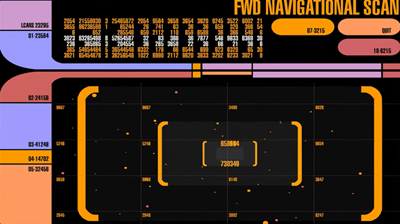 Utilized not only by the Enterprise's Science Division the Navigational Sensors help the Flight Control and Navigation Officers to navigate the Enterprise through space. Their systems include a quasar telescope, passive subspace multibeacon receivers, stellar graviton detectors, a Federation Timebase Beacon receiver, and various IR and UV imagers and trackers that transmit their data directly to the Enterprise's Navigational Computers. From there the Enterprise's Guidance and Navigation Relay reviews the sensor data and converts it into usable information with the flight motion software, feeding directly into the Astrometrics, Flight Control, and Navigational systems.
Utilized not only by the Enterprise's Science Division the Navigational Sensors help the Flight Control and Navigation Officers to navigate the Enterprise through space. Their systems include a quasar telescope, passive subspace multibeacon receivers, stellar graviton detectors, a Federation Timebase Beacon receiver, and various IR and UV imagers and trackers that transmit their data directly to the Enterprise's Navigational Computers. From there the Enterprise's Guidance and Navigation Relay reviews the sensor data and converts it into usable information with the flight motion software, feeding directly into the Astrometrics, Flight Control, and Navigational systems.
Scan Types | |
| Sensor Sweeps look at all area around the Enterprise and provide basic information about the environment around the ship. | |
| Sensor Search scans look at an arc around the vessel and provide enhanced information about that area. | |
| Focused Scans look at a specific location to provide detailed information at the expense of information gathering in other areas. | |
Probes
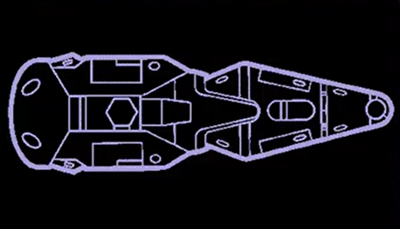 Probes are automated sensor platforms that are used to extend the range and/or sensitivity of a starship's sensor arrays. Fired from the Enterprise's Torpedo Launcher, probes commonly use modified Torpedo casings made of a gamma-welded duranium-tritanium and pressurebonded lufium boronate hull. Currently, the Federation supports ten classes of Probe with their designations indicating their mission profiles. However, a higher-designation probe usually flies more quickly and has a greater range. Featuring an internal powerplant, Probes generate enough energy to remain operational until they either reach their maximum range or cease to function. Their microfusion propulsion systems and/or warp field sustainers are used to travel to their destination and most Starfleet Probes are equipped for remote operation. All probes can withstand atmospheric entry; some are even capable of gently descending through an atmosphere to the surface of a planet to run scans. While primarily a scientific tool, a Probe can be modified to create a makeshift torpedo in an emergency.
Probes are automated sensor platforms that are used to extend the range and/or sensitivity of a starship's sensor arrays. Fired from the Enterprise's Torpedo Launcher, probes commonly use modified Torpedo casings made of a gamma-welded duranium-tritanium and pressurebonded lufium boronate hull. Currently, the Federation supports ten classes of Probe with their designations indicating their mission profiles. However, a higher-designation probe usually flies more quickly and has a greater range. Featuring an internal powerplant, Probes generate enough energy to remain operational until they either reach their maximum range or cease to function. Their microfusion propulsion systems and/or warp field sustainers are used to travel to their destination and most Starfleet Probes are equipped for remote operation. All probes can withstand atmospheric entry; some are even capable of gently descending through an atmosphere to the surface of a planet to run scans. While primarily a scientific tool, a Probe can be modified to create a makeshift torpedo in an emergency.
Probe Types | |||
| Short-range astronomical probes which analyze EM radiation, interstellar chemistry, and subspace fields. | |||
| Short-range astronomical probes which analyze EM radiation, interstellar chemistry, and subspace fields. | |||
| Incorporating stealth technology making them difficult to detect them with sensors, these probes land on planets and return samples, thus providing a detailed on-site analysis of the planet. Crews can also use Class III probes to analyze the capabilities of enemy starships. | |||
| These probes perform close observation of stars and other high-energy phenomena. | |||
| Incorporating stealth technology making them difficult to detect them with sensors, these probes land on planets and return samples, thus providing a detailed on-site analysis of the planet. | |||
| Communicator relays and emergency beacons. To make it harder to detect them with subspace sensors, these probes cannot attain warp speed but have high sublight velocities. When a Class VI probe exhausts its fuel supply, it coasts and broadcasts a recovery signal toward Federation space. The probe’s navigational module facilitates recovery and trajectory tracking. | |||
| Incorporating stealth technology making them difficult to detect them with sensors, these probes orbit an inhabited planet for up to three months to collect information about its inhabitants and relay it to the ship. | |||
| A long-range sensor probe, the Class VIII Probe has long-range sensors with a range of 6 light-years and can travel for approximately 6.5 hours. In crisis situations, they can be used to send a lone passenger on an emergency mission. | |||
| A long-range sensor probe, the Class IX Probe has long-range sensors with a range of 12 light-years and can travel for approximately 12 hours. In crisis situations, they can be used to send a lone passenger on an emergency mission. | |||
| Also known as the Multi-spatial probe, the Class X was designed by the crew of the USS Voyager based upon technology they recovered in the Delta Quadrant. It is capable of long-term exploration in diverse environments. | |||
Science Laboratories
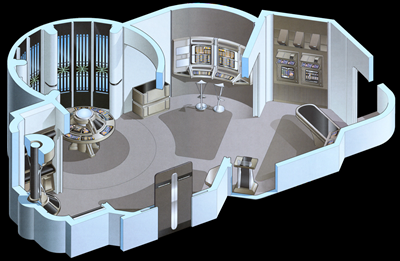 Science Laboratories are specialized facilities aboard the Century Class that provide controlled conditions in which scientific or technological research, experiments, and measurement may be performed for work in experimental or observational science. In its current configuration, the Enterprise has been outfitted with General Science Labs that can be configured based upon mission parameters to fulfill objectives and a variety of specialized research laboratories throughout the vessel.
Science Laboratories are specialized facilities aboard the Century Class that provide controlled conditions in which scientific or technological research, experiments, and measurement may be performed for work in experimental or observational science. In its current configuration, the Enterprise has been outfitted with General Science Labs that can be configured based upon mission parameters to fulfill objectives and a variety of specialized research laboratories throughout the vessel.Featuring state of the art research facilities, the laboratories aboard the Enterprise are capable of performing both short and long-term research, providing detailed information and analysis into their subject of study. Enterprise also benefits from a series of modular laboratories, compartments that can be configured for analysis and investigation depending on mission protocols.
For information on particular laboratories aboard the Enterprise, please visit: U.S.S. Enterprise Science Section.
Categories: Science